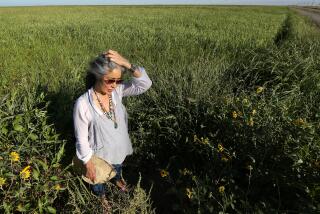The Bamboo Brothers
- Share via
Move over Bedspread King.
Outta the way King of Big Screen TVs.
Make room for the Kings of Bamboo.
That, at any rate, is what Jerry and Rick Chan hope to be.
The San Gabriel-based entrepreneurs, natives of China, are passionate purveyors of all things bamboo, from boats and bicycles to umbrellas, underwear and flooring. The brothers operate a business, Bamboo 54 Inc., that imports the woody stalks in a multitude of forms from China.
Jerry Chan admits that he once thought of bamboo, a member of the grass family, as nothing more than a “tall skinny stick.”
Four years ago he went looking for bamboo to add a tropical flair to a juice bar at his short-lived Pasadena restaurant, Rice, etc. He couldn’t find any bamboo for sale but stumbled upon an ad in the Recycler newspaper: “Free Bamboo. You remove it, you keep it.”
“Don’t bring a machete,” warned the man who was offering up the bamboo. “Bring a pointed shovel.”
Chan spent several hours digging and pulling out the stubborn plant for his juice bar, which met its demise when the restaurant died.
Around the same time, a cousin in Florida called with an inspiration. The cousin, an avid environmentalist, wanted to share with his California kinsmen a business brainstorm he’d had: “bamboo.”
Chan was skeptical, but the timing was right. He and Rick were out of the restaurant business. And from their experience, they were aware that commercial bamboo was hard to come by.
They soon learned that bamboo isn’t just a tall skinny stick and garden nuisance. The very qualities that make the plant a pest--its vigor and invasiveness--make it a perfect raw material for an astonishing array of items.
“I fell in love with the versatility of the product,” says Chan.
As a resource, some have compared bamboo to
the once abundant buffalo, exploited for everything from food and clothing to shelter and fuel. Bamboo is all that and has also been used as an aphrodisiac, a poison antidote, a base for beer and wine, diesel fuel and the filament of a lightbulb.
Unlike the buffalo, though, bamboo shows no sign of dwindling. With more than 1,500 known species and an infamous ability to reproduce, bamboo’s
place on the planet is secure.
Ken Bennecke, president of the Southern California chapter of the American Bamboo Society, a group that focuses on the cultivation and functional uses of bamboo, says it thrives in areas with plenty of moisture and sunlight.
It is especially plentiful in China and Central and South America. Like the Chans, Bennecke fell in love with the variety of the plant, which ranges from tiny to towering, straight to vining, pale green to ebony.
It wasn’t long before the Chans were overseeing production of bamboo furniture, handbags and clothing.
Their unusual clothing line is fashioned from the tiny leaf stems of bamboo. A $69 vest, for instance, sells well in the men’s clothing catalog International Male. “It’s a unique item and we do well with unique items,” says International Male merchandise director Tim McConnell.
And bamboo flooring, harder and more durable than oak or maple, is catching on in commercial and residential spaces. It can take an oak tree 30 to 100 years to reach maturity, but a bamboo plant reaches its full height in just three to five years. Dubbed the “the fastest-growing plant on the planet,” some species grow almost 4 feet per day.
Gary Kanda, a local designer and contractor, uses bamboo flooring in all of the Japanese restaurants he designs, including his most recent, Sai, in Beverly Hills. “I also recommend it to all of my residential customers,” says Gary. “I think it’s superior to hardwood floors and is quite beautiful.”
Last year, the design firm of Cynthia Bennett and Associates chose bamboo flooring for the traditional kitchen of the Pasadena Showcase House of Design.
In a test of tensile strength (the ability to be stretched without breaking), bamboo wins hands down over steel. (Bamboo’s tensile strength is 28,000 pounds per square inch versus 23,000 for steel.) That’s why the abundant bamboo is used for high-rise scaffolding throughout Asia.
“Not a single nail is used. It’s just bamboo woven together with bamboo,” says Chan, with wonder. It’s that same strength and flexibility that protected houses during the violent 1991 earthquake in Limon, Costa Rica. The only houses left standing were those constructed of bamboo.
With that kind of stability, it’s easy to understand why a Chinese poet once wrote, “Man can live without meat, but he will die without bamboo.”
*
The Bamboo 54 Inc. Web site is at https://www.bamboomall.com.
More to Read
Inside the business of entertainment
The Wide Shot brings you news, analysis and insights on everything from streaming wars to production — and what it all means for the future.
You may occasionally receive promotional content from the Los Angeles Times.










